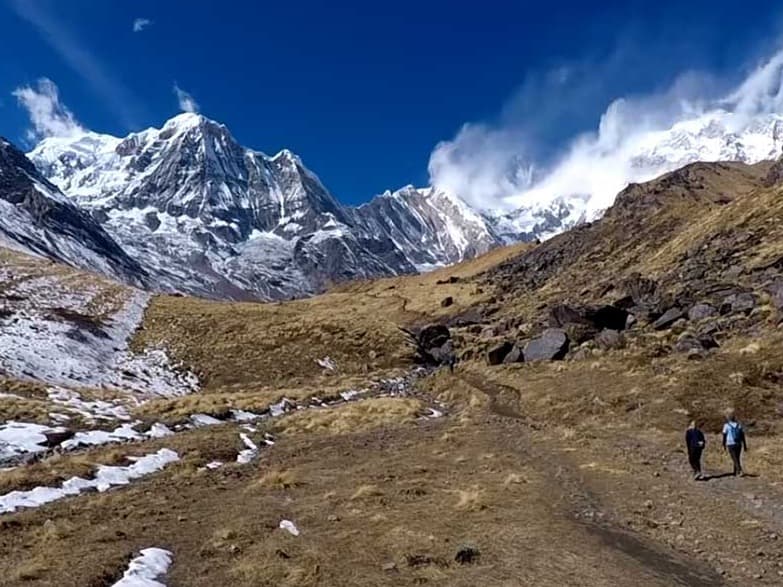Located away in Nepal's Annapurna region, Mardi Himal is home to several ethnic tribes that have weaved a colorful cultural tapestry together, making it more than just a stunning hiking destination.
Although trekkers come from all over the world to see the breathtaking scenery and towering peaks, it is the locals' distinctive customs, kind welcome, and distinct way of life that make the journey memorable.
In this blog, we will explore the cultures and people of the Mardi Himal region, offering an understanding of their way of life, traditions, and close bond with the environment.
Ethnic Diversity
The trekking trails pass through several villages like the Gurung, Magar, and Brahmin communities. The region's unique cultural diversity is enhanced by these groups' contributions.
Gurung Community: In the Annapurna area, the Gurungs are among the best-known ethnic groupings. They frequently served in the British and Indian Gurkha armies, demonstrating their long history of courage. The main sources of income for the Gurung people are farming and raising livestock, and these activities are fundamental to their agrarian way of life. Their bright attire, lively festivals, and traditional music all showcase their upbeat attitude and close-knit community.
Magar Community: Known for their rich oral traditions and culture, the Magars are another notable ethnic community in the area. Their rituals are inspired by both Buddhist and Hindu faiths, and they are primarily farmers. In addition, the Magar people are known for their proficiency in woodcarving and weaving, two ancient crafts that are frequently shown in their houses.
Brahmin Community: The Brahmins in the region often take on roles in religious and educational spheres. They are typically involved in farming and serve as priests in local temples. Their influence in the region’s spiritual practices is notable, as they lead various rituals and ceremonies, contributing to the cultural landscape of Mardi Himal.
Festivals and Celebrations
The villages surrounding Mardi Himal revolve their lives around cultural events. These festivities offer a glimpse into the culture and beliefs of the area through their brilliant colors, traditional music, and dancing.
Dashain: For the Gurung and Magar groups, Dashain is one of the most important holidays. Dashain, which is observed over multiple days, commemorates the goddess Durga's victory over evil. Families celebrate holidays, exchange blessings, and carry out traditions. It's a reunion moment, and happiness and thankfulness.
Tihar: Also known as the festival of lights, Tihar is a five-day festival of great importance. Several creatures and deities are honored on different days. The residents create a joyful atmosphere in their houses by decorating them with vibrant lights and flowers. Families gather together in Tihar to celebrate by singing traditional songs and indulging in delicious handmade desserts.
Maghe Sankranti: The Magar community celebrates Maghe Sankranti, a time to welcome longer days and commemorate the winter solstice. Special delicacies are consumed in celebration, including molasses and sesame seeds, which are said to bring wealth and health.
Traditional Lifestyle
The locals of Mardi Himal have straightforward yet happy lifestyles, deeply rooted in the environment. One of the main jobs in the area is agriculture, where people grow potatoes, rice, corn, and wheat. Their creativity and hard work are evident in the terraced farms that cover the slopes.
Their everyday routines involve not just farming but also raising cattle. Goats and cattle are important for food production as well as for money. The people there frequently carry out customs like raising animals, which is essential to their cultural identity.
Cuisine and Culinary Traditions
The Mardi Himal region's culture revolves heavily around food. The simplicity and flavor of traditional meals are often a reflection of the farming methods and resources that are available.
Dal Bhat: Dal Bhat is a traditional meal consisting of lentil soup (dal) paired with rice (bhat) and a variety of side dishes, such as pickles and vegetables. Both locals and travelers frequently eat this lunch, which gives them energy for the next part of their journey.
Gundruk: A popular delicacy in the area, this is a fermented leafy green vegetable. It is frequently added to soups and stews or given as a side dish, demonstrating how skilled the inhabitants are at preserving food.
Sel Roti: A traditional rice-based doughnut, sel roti is often made during festivals and special occasions. Its crispy exterior and soft interior make it a delightful treat that is enjoyed by both locals and visitors.
Hospitality and Community Spirit
The friendliness of the locals in the Mardi Himal region is one of its most amazing features. Trekkers are made to feel at home by the genuine warmth and warm greetings of the locals. Along the hiking path, teahouses and lodges are frequently owned and operated by families, who treat visitors like members of the family.
The people support one another throughout festivals and harvests, demonstrating a strong sense of community. Interactions with locals reveal a supportive atmosphere that is fostered by this kinship. Many times, visitors depart with enduring connections and recollections of common experiences.
Spiritual Connection to Nature
The surrounding towns of Mardi Himal regard the mountain’s spiritual symbols as much as they do physical markers. Many residents think that life is connected to nature and that the mountains are sacred. Their everyday activities, rituals, and customs all reflect this regard for the natural world.
Local priests and shamans have a deep connection to the earth, which is reflected in the yearly rites and ceremonies they conduct. Offerings to the mountains and gods are a means to show appreciation and ask for benefits in the form of health, wealth, and a good crop.
Conclusion
Trekking to the top of Mount Everest is an experience that takes you not only through breathtaking scenery but also deep into the customs and cultures of the region.
For visitors who travel to this fascinating region, the varied ethnic communities, their colorful festivals, traditional ways of life, and kind hospitality make for a unique experience.
You will learn that the genuine spirit of Mardi Himal is found in the unforgettable experiences and relationships made along the route, not simply in the stunning scenery. This will become apparent as you hike the paths and engage with the people.
Take advantage of the chance to learn from the Mardi Himal people and allow their culture to enhance your trekking experience, leaving you with lifelong memories.






